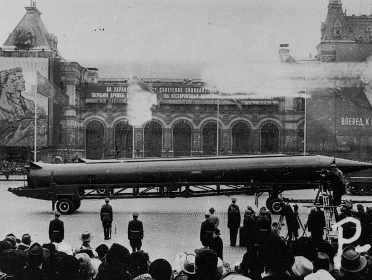Causes of the Cuban Missile Crisis

Table of Contents
- Discovery of the Soviet Missile Bases in Cuba
- Cuban Revolution
- Kennedy's Policy Towards Fidel Castro
- US Missiles in Turkey and Construction of the Berlin Wall
- Relationship Between Kennedy and Khrushchev
Quick Facts
The Cuban Missile Crisis brought the Soviet Union and the United States to the brink of a nuclear conflict.
It broke out after US spy planes discovered the Soviet missile bases under construction in Cuba.
Several events before the outbreak of the crisis tensed the relations between the rival superpowers including:- the failed Pig Bay Invasion
- the Cuban Project or Operation Mongoose
- deployment of PGM-19 Jupiter medium-range ballistic missiles with nuclear warheads in Italy and Turkey by the United States
- construction of the Berlin Wall
The crisis ended on October 28, 1962, when Radio Moscow broadcasted Khrushchev's statement that the missiles in Cuba will be dismantled.
Discovery of the Soviet Missile Bases in Cuba
The Cuban Missile Crisis was the most serious confrontation between the United States and Soviet Union during the Cold War and brought the nations to the brink of a nuclear conflict. The immediate cause of the crisis were the photos of what was believed to be a proof of the Soviet missile bases under construction in Cuba taken by the U2 spy planes on October 14, 1962. The United States answered with a naval blockade of Cuba at the same time when the Soviet cargo ships were on their way to the island on October 22, while the US President John F. Kennedy announced the American people that they are under threat on television.
Cuban Revolution
Both the United States and Soviet Union have undertaken several actions that increased the tensions between the countries in the late 1950’s and early 1960’s. The chain of events that led to to the outbreak of the Cuban Missile Crisis started with the overthrow of the pro-American Cuban dictator Fulgencio Batista by Fidel Castro in 1959. Once in power, Castro nationalized the American companies in Cuba which caused an outrage in the United States. The US government answered with an embargo against Cuba in 1960 forcing Castro to turn to the Soviet Union. After he reached an agreement with the Soviets to purchase 1 million tons of Cuban sugar per year, he continued to nationalize the American commercial and private properties in Cuba.
Kennedy’s Policy Towards Fidel Castro
Kennedy won the US presidential election of 1960 partly also due to his strong anti-communist foreign policy. He approved the Pig Bay Invasion just three months after assuming the office with an aim to remove Castro and stop the spread of communism in Latin America. Despite the failed invasion of the recruited anti-Castro Cuban exiles in April 1961, Kennedy authorized another operation against Fidel Castro known as the Cuban Project or Operation Mongoose in November 1961 pushing the Cuban leader closer to the Soviet Union. But it was not the American policy towards Cuba that brought the Soviet leader Nikita Khrushchev to the idea of placing the intermediate-range nuclear missiles on the island only 90 miles from Florida.
US Missiles in Turkey and Construction of the Berlin Wall
In April 1962, the United States deployed the PGM-19 Jupiter medium-range ballistic missiles with nuclear warheads in Italy and Turkey. Considering that the Cold War was characterized by conventional and nuclear arms race, the Soviet counter-missile measures were a logical response to the US missiles in Turkey. And there was no better place than the pro-Soviet Cuba due to its proximity to the United States. However, the Soviet deployment of missiles in Cuba were not only a reaction to the US missiles in Turkey. One year earlier, the Soviets (officially East Germans) built the Berlin Wall which completely cut off West Berlin from the surrounding East Germany. The wall de facto divided the city into two halves despite the fact the Potsdam Agreement foresaw joined Allied administration of the city of Berlin.
Relationship Between Kennedy and Khrushchev
The responsibility for the Cuban Missile Crisis which nearly turned into a nuclear holocaust partly also rests on the relationship between the US and Soviet leaders. Kennedy was humiliated by the failed Pig Bay Invasion and his meeting with Khrushchev at the Vienna Summit on June 4, 1961 made his frustration even worse. He considered the Vienna Summit a disaster and felt the need to demonstrate more strength to Khrushchev who was very self-confident, bold and refused to make any concessions in foreign policy until October of 1962. Although Kennedy was criticized by some historians for doing nothing against the erection of the Berlin Wall, he apparently convinced Khrushchev that he is capable of starting a nuclear war. On October 28, 1962 Radio Moscow broadcasted the Soviet leader’s statement that the missiles in Cuba will be dismantled which ended the crisis.




